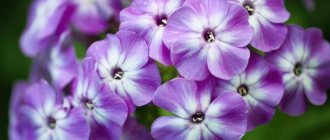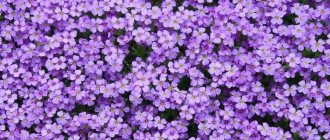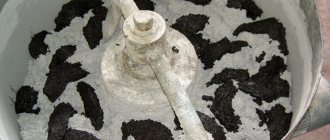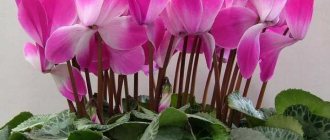Author: Natalya Category: Houseplants Published: February 22, 2019Last edits: January 11, 2021
- Reproduction methods
- Nephrolepis exaltata
The plant nephrolepis (lat. Nephrolepis) belongs to the genus of ferns of the Lomariopsis family; in some classifications it is classified as a member of the Davalliaceae family. The Latin name is derived from the Greek words “nephros” and “lepis”, meaning “bud” and “scale” in translation and containing a hint of the shape of the veil. About 30 species of nephrolepis grow in nature, distributed throughout the world, but the homeland of the nephrolepis plant is the shady forests of the tropics of Africa, America, Australia and Southeast Asia. In culture, nephrolepis fern is used as a potted or hanging plant to decorate interiors - in addition to being very beautiful, nephrolepis fern perfectly purifies the air.
Planting and caring for nephrolepis
- Flowering: does not bloom.
- Lighting: diffused light (near the window, as well as on the northern, western or eastern windowsill). The plant requires 14-16 hours of daylight.
- Temperature: during the growing season – 20-24 ˚C, during the dormant period – about 15 ˚C.
- Watering: the higher the temperature in the room, the more often and more abundantly you need to water. There is only one principle: the substrate is moistened as the top layer of soil in the pot dries.
- Humidity: high. Frequent spraying, periodic showers and keeping on a tray with wet pebbles are recommended.
- Fertilizing: from March to September 3-4 times a month with complex fertilizers for decorative deciduous plants. When wintering in a warm room, one feeding per month is sufficient.
- Dormant period: from October to February.
- Transplantation: young plants are replanted annually, adults - once every 2-3 years.
- Reproduction: vegetative only: suckers, shoots and dividing the bush.
- Pests: aphids, whiteflies, spider mites, rootbugs and scale insects.
- Diseases: loss of decorativeness due to improper care and dry air.
Read more about growing nephrolepis below.
Pests and diseases
Ferns can be damaged by pests such as spider mites, scale insects, and mealybugs. It is necessary to treat with insecticides.
The appearance of dark spots on the plant indicates sunburn - move the plant to the shade, spray it more often, and water generously.
Rot appears from stagnation of water - the soil must be completely dried and treated with a fungicide. Continue watering sparingly.
Drying of leaves occurs due to lack of watering or lack of light. Move the fern to a more sunny place and moisten the soil.
When the leaves turn brown and eventually dry out and fall off, the plant may be exposed to a draft or the air temperature in the room is low, or it may also happen from watering with cold or hard water.
If growth rates do not increase for a long time, most likely the pot has become small - it is necessary to transplant it into a larger container.
Botanical description
Nephrolepis flower is a herbaceous plant, epiphytic or terrestrial, with a short rhizome, a rosette of light green, short-petioled pinnately compound leaves up to 70 cm long, consisting of lanceolate, serrate-crenate along the edge of segments up to 5 cm long, on the lower side of which on both sides the midrib contains round sori. With age, the leaves turn yellow and fall off. Leafless shoots, covered with scales and easily rooting, extend from the rhizome.
Nephrolepis Green Lady
The species was named “Green Lady” due to the elegance and aesthetics of the plant. Nephrolepis is highly decorative; its leaves are very delicate, light green in color, and droop. The leaves are curled at the tops, the leaf blades are wavy, which gives an openwork appearance to the contours. It is recommended to grow in good diffused light, but tolerates partial shade and artificial lighting. In this case, the light must be constant and not interrupted. Can be planted alone or together with another plant. This species is very similar to another variety of nephrolepis - Sonata, but its leaves are less drooping and the color of the leaves is lighter.
Caring for nephrolepis at home
Growing conditions
If you decide to purchase indoor nephrolepis, you first need to familiarize yourself with the conditions for its cultivation. Indoor fern nephrolepis prefers diffused light, so it would be better to place it near a window where direct sunlight does not reach.
If you prefer to keep flowers on window sills, windows of northern, western or eastern orientation are suitable for nephrolepis. However, the length of daylight hours in the plant's natural habitat is 14-16 hours, so if you want to see the house fern nephrolepis in its best form, be prepared to provide additional lighting for it. Nephrolepis is tolerant of fluorescent lamps, so it can often be seen in hotel lobbies and large office centers.
- Propagation by cuttings
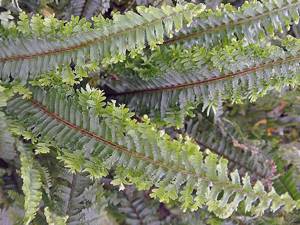
The optimal temperature regime for fern in the warm season is 20-24 ºC, but with frequent spraying of the leaves it can withstand higher temperatures. In winter, comfortable conditions for resting nephrolepis are a temperature of about 15 ºC, but the main thing is to keep the plant as far as possible from heating devices. If you do not have the opportunity to place the plant in a cool room during the dormant period, leave it in its usual place and continue spraying and watering - nephrolepis will continue to develop, although not as intensely as in the summer.

Caring for nephrolepis fern includes regular feeding of the plant with complex fertilizers for ornamental foliage plants in a concentration equal to one-fourth of that specified by the manufacturers. Fertilizing is applied approximately three to four times a month from March to September - provided there is a cool winter, the plant does not need fertilizers for the rest of the year. If the fern remains warm in winter, then you can feed Nephrolepis in winter no more than once a month.
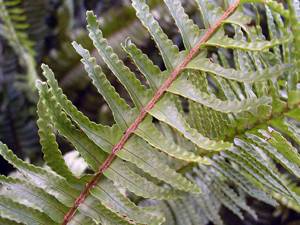
Watering
As for watering nephrolepis, its frequency and water consumption at a time depend on the temperature in the room: the higher it is, the more frequent and abundant the watering should be. The top layer of soil in the pot should dry out between waterings. If the indoor plant nephrolepis rests in cool conditions in winter, it does not need frequent watering and large amounts of water - watering is carried out as the top layer of soil dries.
To organize a high humidity regime for a plant in the warm season, it is recommended to spray its leaves with non-cold, settled water as often as possible and it is advisable to give nephrolepis a shower at least once a month. You can keep the fern on a tray with wet pebbles or expanded clay so that the bottom of the pot does not touch the water. By the way, nephrolepis also needs to be watered with settled or filtered water at room temperature.
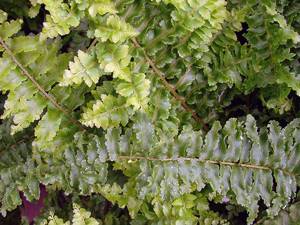
Transfer
Young ferns are replanted every spring, adults - once every two to three years. It is preferable to grow nephrolepis in a plastic container rather than a ceramic one - plastic retains moisture in the soil longer. Since the plant’s root system is superficial, choose a shallow, wide pot for it. Before transplanting nephrolepis, place a layer of expanded clay in the new pot so that excess water does not stagnate in the roots of the plant, then place a layer of substrate in it.
The soil for nephrolepis should be light: high-moor peat, greenhouse and coniferous soil in equal parts. It is advisable to add a little bone meal to the soil mixture in a proportion of 5 g per 1 kg of soil. If you don’t want to bother with making a soil mixture, purchase a ready-made acidic substrate for ferns in the store, although nephrolepis will also be suitable for soil for camellias, calla lilies or hydrangeas with a pH value of 4.5-5.5. When transplanting, the root collar is left above the soil surface. The transplanted plant initially needs constantly moist soil and high air humidity.
- Homemade hyacinth: planting, forcing, growing

Pests and diseases
Nephrolepis at home with insufficient care is affected by whiteflies, aphids, scale insects and spider mites. You can cope with these harmful insects by treating the plant with insecticides Actellik, Aktara and similar preparations.
Sometimes readers ask why nephrolepis leaves dry out. Most often, nephrolepis dries out from insufficient or infrequent watering. If only the tips of the leaves dry out, this is a sign that the air humidity level in the room is low for the plant.
If leaves turn brown, curl, and fall off, it may be due to drafts, low temperatures, or watering with cold, chlorinated, or hard water. When dry spots appear on fern leaves, these are most likely burns from direct sunlight.
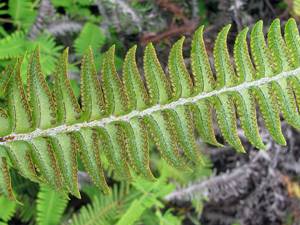
Properties of nephrolepis
It is believed that nephrolepis absorbs energy and electromagnetic radiation harmful to humans, improves immunity, instills vigor, and cleans the air of dust and harmful fumes. You can keep nephrolepis at home, placing it near the TV or next to the computer, or you can grow it in the office, and it will be in place everywhere. Psychologists say that proximity to nephrolepis reveals perseverance, perseverance and prudence in a person - precisely those qualities that we all lack, however, it should be borne in mind that tobacco smoke reduces the effect of these wonderful properties of the plant.
Soil for nephrolepis and fern fertilization
Under normal conditions, replanting is carried out in the spring and is often combined with fern propagation by dividing the rhizomes. In order for the specimen transferred to a new pot to quickly acclimatize and grow, you can purchase ready-made fern soil for it or prepare the mixture yourself.
The plant feels comfortable in a slightly acidic or neutral substrate, which perfectly allows water and air to pass through and does not interfere with the development of the root system. If you make the soil yourself when caring for nephrolepis and growing it at home, add the following to it in equal parts:
- fertile garden soil;
- sorted peat;
- well washed river sand;
- soil from under coniferous crops.
Chopped sphagnum moss and crushed charcoal can be useful components. These additives not only structure the substrate, but also protect the plant from bacterial flora and decay.
If the acidity of the soil for nephrolepis goes beyond pH 5.0–6.0 units, dolomite flour must be added.
From spring to autumn, the fern is fed twice a month using complex fertilizers for decorative deciduous crops. In winter, the frequency of fertilizing is reduced to once a month.
Reproduction of nephrolepis
Reproduction methods
Nephrolepis reproduces by dividing the rhizome, shoots and suckers. The fact is that many varieties of this genus are sterile, and even if they form spores, they do not convey the characteristics of the mother plant. That is why nephrolepis is propagated vegetatively at home.
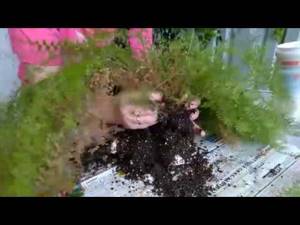
Dividing the bush
Usually the bush is divided in the spring, at the same time as the plant is replanted. Only large plants that have several growing points can be divided. The cuttings, each of which must have at least one growing point, are planted in a separate plastic container, watered and rooted, creating conditions of high humidity at a temperature of 15-18 ºC. However, do not expect quick success: for normal development, the divisions need to build up the root system, and this takes time.

Reproduction by offspring
Nephrolepis tendrils (leafless shoots) are taken to the side and buried in a bowl with light soil to a depth of 0.5-0.8 cm, leaving the tops above the surface. During rooting of the shoots, the soil in the bowl should be slightly moist at all times. After 10-15 days, the shoots take root, and after another time, new shoots appear. When the plants become stronger, they are separated from the mother plant and transplanted into individual containers.
- Conditions for growing gardenia on a window
Problems when growing nephrolepis
When growing nephrolepis at home, certain signs may appear that the plant is uncomfortable. For example, if dark spots appear on a fern, then most likely it is being overexposed to the sun. To solve this problem, it is necessary to move the plant into the shade and do not forget about watering and spraying with water.
If the appearance of rot is observed on the nephrolepis, then most likely the reason is that there is stagnation of water in the pot. In other words, you have poured an excessive amount of water into the flower. To solve this problem, you need to dry all the soil, and after that continue to water the plant (again, it is very important not to overdo it).
If nephrolepis begins to dry out, you need to look for the cause either in the watering mode (the plant is not watered enough) or in the lighting (the plant does not have enough light). In this case, it is recommended to move the fern to another, more illuminated place and be sure to moisten the soil.
If the fern has not experienced an increase in growth for a long time, this may be due to a lack of space in the pot. You just need to transplant the flower into a larger pot.
Types and varieties
Not many types of nephrolepis are grown in culture, but we will tell you about the most popular ferns.
Nephrolepis exaltata
In nature, it is an epiphyte or terrestrial herbaceous plant with a vertical rhizome, on which a rosette of large, pinnately compound light green leaves up to 70 cm long on short petioles develops. The leaves consist of lanceolate segments up to 5 cm long, serrate-cense along the edges. As they age, the leaves turn yellow and fall off. On the underside of the segments on both sides of the midrib, sori with spores mature. Scale-covered lashes (stolons) are formed on the rhizome, which easily take root. Nephrolepis sublime is native to the tropical regions of Southeast Asia.
This species has many garden forms and varieties:
- nephrolepis Roosevelt - a large fern with fronds with wavy segments sticking out in different directions;
- nephrolepis Maasa - a compact variety with wavy leaves;
- Nephrolepis Scott is also a small plant with segments curled at the edges;
- nephrolepis Green Lady is a very beautiful fern with a lush fountain of openwork wavy leaves with a pointed tip, crowning a vertical rhizome;
- Nephrolepis Emina is a low-growing compact variety with almost erect fronds with curly leaves with carved teeth along the edges;
- Nephrolepis Boston, or Nephrolepis Bostonian, is an upright growing plant that was bred in the USA and literally immediately became popular among breeders: on its basis, varieties were bred with double-, triple- and quadruple-pinnate fronds reaching a length of 120 cm, the segments of which depend on varieties can be wavy or twisted:
- nephrolepis Hills and Fluffy Raffles - ferns with double-pinnate leaves;
- Whitman's nephrolepis is a plant with triply pinnate leaves;
- nephrolepis Smith - nephrolepis with four-pinnate leaves.
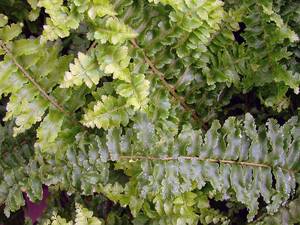
Nephrolepis cordifolia
It differs from Nephrolepis sublime by swellings on underground shoots, similar to tubers, covered with silver or white scales, and also by the fact that its fronds, with a denser, sometimes tiled arrangement of rounded segments, are directed upward almost vertically. Nephrolepis cordifolia is native to subtropical forests of both hemispheres; this species has been in cultivation since 1841; it is often used to make bouquets.

Nephrolepis biserrata
Originally from Central America. It is distinguished by long leaves, sometimes reaching 2-2.5 m in length in greenhouse conditions. Nephrolepis ensiform can only be grown in large rooms.
Types of Nephrolepis domestica with photos and names
Nephrolepis exaltata
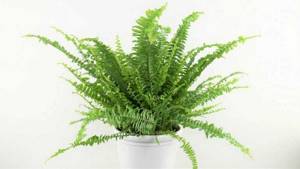
It has a rosette of long (70 cm or more), large, short-petioled leaves. The segments, like the leaves themselves, have a lanceolate, pinnate shape. The color is light green. The structure of the leaves is imparipinnate, they are curved towards the bottom. The leaves are wrinkled and toothed. The edges of the segments are covered with two rows of rounded sori in which spores mature. Long scaly shoots grow from the rhizome, have no leaves, and are capable of rooting. Needs good lighting.
The species is the ancestor of varieties with leaves of various complex shapes:
"Boston"
Has shorter, wider, erect fronds. Dwarf variety. Segments up to 7 cm long, more than 1 cm wide. The leaves are strongly dissected and wavy along the edges.
"Teddy Junior"
The variety is distinguished by lush, wavy leaves of complex shape. A very beautiful decorative variety.
"Rooseveltine"
An adult plant has wide, not long fronds, the segments are directed in different directions.
Nephrolepis cordifolia

It has a dense arrangement of segments that overlap each other and have a characteristic compaction. The leaves practically do not bend, look vertically upward and have a rounded shape. Underground stolons have tuberous growths that store water and are used for reproduction. Tolerates dry indoor air and light shading well.
Nephrolepis - signs
Fern nephrolepis is a very popular plant, maybe that’s why there are legends about it, it is the central character of many superstitions and signs. Some talk about the positive effect of the plant on human health and the environment, while others attribute witchcraft properties to nephrolepis that can influence a person’s fate. An ancient legend says that none of the people could see the fern flower, because on the night of Ivan Kupala, when it blooms, it is plucked by an invisible hand, and all sorts of mystical horrors await those who go into the forest in search of this flower.
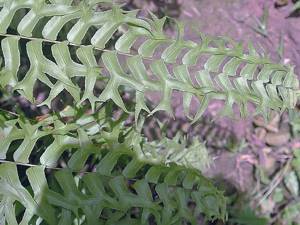
Another belief says that the fern scares away evil spirits, protects the house from evil witchcraft and black magic, preventing the evil eye or damage from being cast on the owners. They also say that fern brings success in business, has a positive effect on material well-being - it attracts money into the house, protects its owners from irrational actions and impulsive spending. It is said that there have been cases of sudden enrichment that are associated with the presence of ferns in the house.
If people of different temperaments live in a house, fern helps to establish good harmonious relationships between them. Under the influence of his aura, aggressive manifestations of people’s character are softened, temper goes away, and confrontation is smoothed out. This is probably why nephrolepis is called the “golden mean” plant.
Which of the stories about ferns is true and which is fiction, everyone decides for themselves. However, I must say that I personally have not felt any negative effects of indoor nephrolepis on my life. For me, nephrolepis is a non-capricious, spectacular plant that brings beauty to the house, purifies the air in the apartment and creates a cozy atmosphere. And let me finally give you some advice: do not be afraid to grow nephrolepis in your home and do not listen to those who themselves live with fears and prejudices.
Signs and superstitions
You can often hear that the fern is called the “golden mean plant.” Supposedly it has a beneficial effect on establishing harmonious relationships in a house where people with different temperaments live. In a home where nephrolepis grows, a calmer and more trusting atmosphere is established; there is no place for aggressiveness and hot temper. that the fern attracts wealth into the house , sometimes unexpected and even unheard of. Along with this, it is considered a talisman against bad energy, evil people and sorcerers.
Along with positive properties, nephrolepis is also credited with a mystical origin. The belief that ferns bloom only on the night of Ivan Kupala is known to everyone, including thanks to Russian fairy tales and feature films. And the one who sees this flower will have a bad life all his life, since only mystical otherworldly forces can see a fern flower, and a person is forbidden to try to see a fern flower.
Fighting diseases and pests and the magical properties of fern
If Nephrolepis is insufficiently or improperly cared for, it can be affected by various diseases or pests. The most common “guests” on this garden flower are scale insects, spider mites and some types of aphids. They should be combated seasonally, using special preparations such as Actellik, Aktara, Antiklesch and other active insecticides.
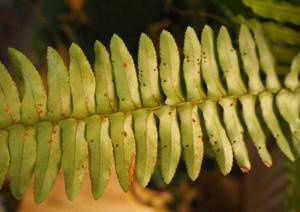
Yellowing of the leaves around the edges or completely indicates too low a room temperature, insufficient watering, or the use of highly chlorinated water.
A healthy flower has bright leaves, and the appearance of a pale shade indicates the need for fertilizing and an early replanting of the plant. Dotted brown spots on sheet branches may be the result of sunburn. This means that the fern is standing under the scorching rays of the sun, and the leaves are drying. Therefore, it must be removed to another part of the room with more comfortable conditions.
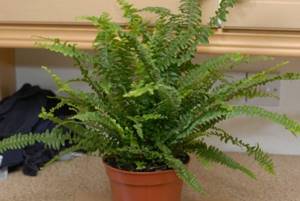
Nephrolepis is considered a positive plant for human life. Florists recommend placing it next to a TV, computer and other devices with a certain degree of radiation. Psychologists note that being around him improves mood and increases perseverance at work, and also helps improve relationships among people of different temperaments.
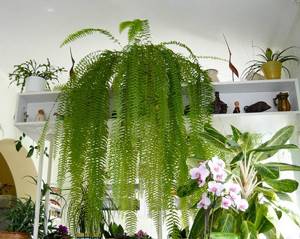
According to popular belief, it scares away evil spirits in the house and protects its inhabitants from the influence of black magic, the evil eye and damage. Other signs speak of his ability to reduce aggressiveness and intensity of passions. In any case, the Nephrolepis fern is an excellent interior solution that will improve the atmosphere indoors and outside.
Reproduction at home - three ways to grow a healthy flower
Most often, ferns are propagated in three ways: by dividing the bush, by suckers or shoots. Each of the options, with the right approach, allows you to grow a beautiful and healthy plant that will complement the interior and improve the air quality in the apartment.
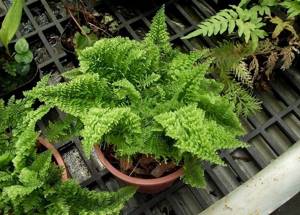
In its natural habitat, ferns reproduce by spores. For indoor cultivation, spores are carefully scraped off the underside of the cut leaf, then thoroughly dried, stored in a refrigerator or cellar in special containers, and sown in early spring.
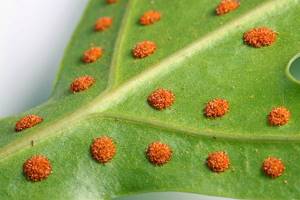
But, as practice shows, often the resulting Nephrolepis spores are sterile and are not able to convey any signs of the mother flower outside their environment. Therefore, the vegetative method of propagation at home is more common and effective.
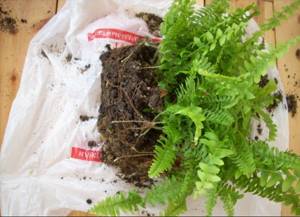
The bush is divided in the spring growth period simultaneously with the plant being transplanted into a new container. Usually only large ferns with several active growth points are cut. The resulting cuttings are planted in spacious pots with properly prepared soil. Then water and root at a temperature of +15-18 degrees in conditions of high air humidity.
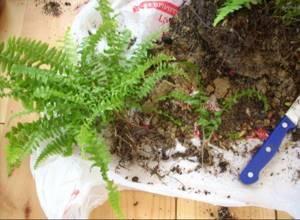
You won’t be able to get quick results when dividing a bush. For a fern to grow a healthy root system, it will take time and the right conditions to maintain it. Another effective method of propagation is the use of offspring (layers), which in this case are leafless shoots of the plant.
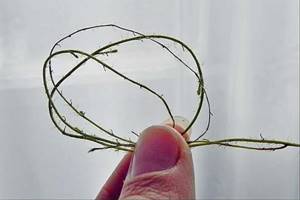
They are planted in pots with light soil, laying them 0.5-0.8 centimeters deep so that the main part with the tops remains on the surface. During the rooting process, which, if planted correctly, lasts from 10 to 15 days, the soil in the bowl should be constantly moist, and the room temperature should be set within +17-19 degrees.
After rooting of the cuttings, the newly emerged young shoots are carefully separated from the mother flower and transplanted using technology into new containers. Regardless of the planting method, it is better to choose plastic pots that are shallow, but wide enough, because Nephrolepis has a superficial type of root system. Unlike ceramics, plastic retains moisture longer, which has a beneficial effect on the formation of a young plant.
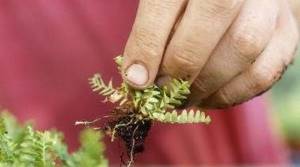
At the bottom of the pot you can put a layer of suitable drainage made of expanded clay or small pebbles, broken bricks, etc. The soil for the fern should be as light as possible. A good option is to use a mixture of peat, deciduous and coniferous soil, which are mixed in equal proportions. The composition can be diluted with a small amount of lime or bone meal at the rate of 5 g per 0.5 kg of soil.
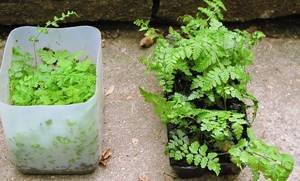
Also suitable is a special soil for ferns, which is sold in hardware stores, or mixtures for hydrangeas, callas or camellias with low hydrogen values.



